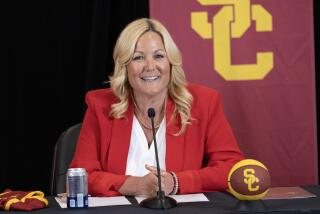The High Price of Success : Colorado State Would Love a Winning Football Team, But Right Now the University Can’t Pay the Price
FORT COLLINS, Colo. — A winning football team costs more money than Colorado State has.
It is the opinion of athletic officials across the United States and within Colorado State that a major reason the football program has suffered four straight losing seasons and took the field Saturday against Brigham Young a decided underdog is that the Rams can’t afford success.
Colorado State operates on a frugal budget, one that coach Leon Fuller said “probably spends less money on football than anybody in the Western Athletic Conference. The reason we’re at the bottom is there’s not any money to spend.”
A training table for the entire football squad’s daily use is a staple at most universities. “To get big and strong like you need to in this sport, you need to have a training table specially designed for the athlete. We don’t have that now,” said Fuller.
The Rams get by with a training table that serves nothing but dinner. And only half the squad gets to partake. “We can’t afford more,” Fuller lamented.
While gleaming, million-dollar football dorms sit elsewhere, the Colorado State players’ abode is a single wing renovated by their own hands.
The Rams must heavily recruit Colorado because a wider talent search is cost prohibitive. Long-distance recruiting visits drain too much from the budget. “We’ve got a good package to sell here, a lot to offer, but if we can’t get kids to see it, we can’t sell it,” said John Glass, the school’s director of athletic fund-raising.
Even fund-raising efforts are hampered by financial shortages. “It takes money to make money,” said Glass.
Glass’ blunt assessment: “It’s going to be very difficult for us to ever have a big winner (in football) without more financial support than we’re getting.
“How is CSU going to win when it’s not raising enough money? And we’re not raising nearly enough money here. I mean, we’re not close to what we need to be doing to make a (positive) impact on the program.”
In fiscal year 1984-85, Colorado State attracted $433,000 in athletic donations. The sum is impressive until compared with other universites. Annual contributions of more than $1 million are commonplace nationwide, and schools receiving much larger sums (Clemson got $4.9 million in cash gifts last year) are not hard to find. That’s because the expense of fielding a college football team worthy of a top-20 ranking is staggering.
At current fund-raising levels, “If (Colorado State) indeed does want to compete nationally in football, frankly I doubt they can do it,” said John Hopkins, Oklahoma State’s director of athletic gifts.
Colorado State Athletic Director Fum McGraw pledges commitment to a football team capable of winning the WAC, an accomplishment that must be considered more than regional success since Saturday’s opponent, Brigham Young, the defending conference champ, is also the returning national titlist.
An undeniable cause-and-effect relationship exists between successful fund-raising and winning football because “fund-raising is the bloodline of a program’s revenue,” said Ron Scott, director of development at the University of Colorado.
“Donations certainly have had a major impact in the past and will have an even greater impact in the future on the successes of athletic programs,” added UCLA associate athletic director Rick Purdy.
Said Oklahoma State’s Hopkins, “If you’re cutting corners, it’s going to show up”--on the scoreboard, and in the eyes of prospective recruits.
There’s no doubt Colorado State has to cut corners. “With us, if we’ve got even a $3,000 expenditure--one another school probably wouldn’t give a second thought to--we’ve got to look at it very closely,” said Glass.
The Rams have made capital improvements in their football business during Fuller’s four years as coach. Donations have steadily--if slowly--increased since the arrival of Glass in 1981, when he said the booster club accomplished nothing. “They met once a month and bitched.”
Colorado State has 16,000 graduates in metropolitan Denver. What could be a lode for Colorado State athletic coffers is instead a pathetically empty well.
More to Read
Go beyond the scoreboard
Get the latest on L.A.'s teams in the daily Sports Report newsletter.
You may occasionally receive promotional content from the Los Angeles Times.










